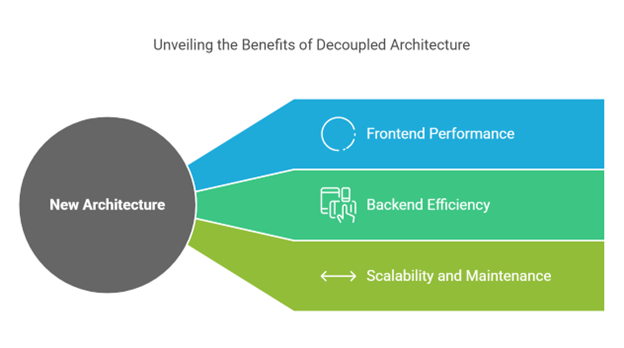Problem
Our organization managed a Drupal-based website serving as both the frontend and backend for content delivery and user interactions. Over the years, as the website’s content and user base grew, performance issues became increasingly apparent. Page load times were sluggish, negatively affecting user experience, and scalability became a concern. Completely overhauling the site was deemed impractical due to the effort and resources involved. We needed a cost-effective, sustainable solution to improve performance without disrupting the core functionalities.

Proposed Solution
To address these challenges, we decided to decouple the architecture by implementing Gatsby as the frontend while retaining Drupal as the backend API service. This approach allowed us to leverage the strengths of each platform:
Gatsby for the Frontend
- Gatsby’s static site generation (SSG) ensured faster page loads and improved overall performance.
- The ability to prefetch resources reduced latency and enhanced user experience.
- A modern, React-based architecture provided flexibility for frontend development and a rich ecosystem of plugins.
Drupal for the Backend
- Drupal’s robust content management capabilities continued to serve as the source of truth for structured content and user data.
- The existing user dashboard, which required dynamic, user-specific data, remained within the Drupal framework to capitalize on its strengths in handling such functionalities.

Implementation Process
Backend Configuration
- Enabled Drupal’s JSON:API module to expose content and other entities via a RESTful API.
- Defined and documented API endpoints for Gatsby to consume.
Frontend Development with Gatsby
- Developed a new frontend with Gatsby, consuming data from Drupal’s APIs.
- Configured Gatsby’s build process to fetch content during the build phase and generate static pages.
- Implemented Gatsby plugins for image optimization, SEO, and analytics to ensure a seamless user experience.
Integration and Testing
- Integrated the Gatsby frontend with the Drupal backend.
- Conducted extensive testing to ensure compatibility, data integrity, and performance improvements.
- Migrated traffic gradually to the new frontend to minimize downtime.

Resolution
The new architecture delivered significant performance improvements:
Frontend Performance
- The Gatsby-powered frontend resulted in near-instant page loads due to its static site generation capabilities.
- The use of modern web technologies improved SEO rankings and user engagement metrics.
Backend Efficiency
- By offloading the content delivery responsibilities to Gatsby, Drupal’s workload was reduced, improving its responsiveness for backend tasks such as user dashboard management and content updates.
Scalability and Maintenance
- The decoupled architecture allowed independent scaling and development of the frontend and backend.
- Gatsby’s static assets were easily deployable to CDNs, further enhancing scalability.

Conclusion
The decision to decouple the Drupal site with Gatsby as the front end proved to be a successful strategy for addressing performance challenges. This hybrid architecture retained the strengths of Drupal for backend management while leveraging Gatsby’s modern capabilities for a fast and efficient user-facing experience. This case study demonstrates how thoughtful integration of technologies can extend the lifespan and utility of existing systems while achieving substantial performance gains.